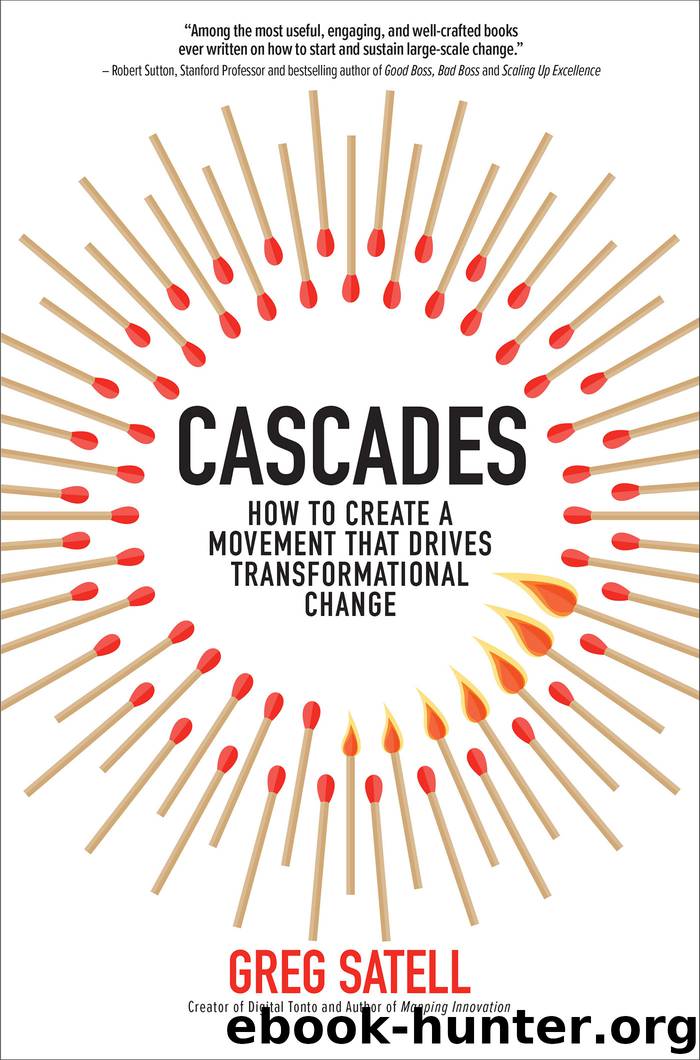Cascades by Greg Satell

Author:Greg Satell
Language: eng
Format: epub
Publisher: McGraw-Hill Education
Published: 2019-04-29T16:00:00+00:00
HOW A STRATEGY COMES TOGETHER
* * *
It was 1958 and John Lewis was a sophomore at the American Baptist Theological Seminary in Nashville, Tennessee, when he met James Lawson. Thirty years old, but worldly beyond his years, Lawson had already been to jail for refusing to report for the draft. Although he would have been eligible for a ministerial or student deferment, out of principle he never sought to obtain one and entered captivity willingly. After being released from prison, he went to India as a Methodist missionary, where he studied the principles of Satyagraha with several of Gandhi’s disciples. He came to Nashville with the dual purpose of pursuing a doctorate at the Vanderbilt Divinity School and serving as a field secretary for the Fellowship of Reconciliation (FOR), a pacifist organization active in the civil rights movement.29
Lewis was immediately taken in by Lawson and began attending his Tuesday evening workshops, which indoctrinated students in Gandhi’s methods. Before long, Lewis convinced his friend Bernard Lafayette to join the slowly growing coterie that included future civil rights luminaries such as Diane Nash, James Bevel, and Marion Barry. Eventually, the students organized themselves into the Student Movement. They wanted to make a difference through a direct nonviolent action, but what kind of action they would undertake was still unclear.30
As young, passionate, and idealistic students, many from out of town, they were clearly on the far left side of the Spectrum of Allies, with little connection to the other groups with higher thresholds of resistance. To a large extent, they had no voice in Nashville affairs, few ties to the community, and little shared consciousness with the people that did. Whatever action they took, it had to be one that would mobilize their passive allies and make inroads into those neutral and even passively opposed to the issue of racial integration. What they could not afford was to do anything that would make them appear to be out-of-town rabble-rousers, inspire resistance to change, and set the movement back.
Lawson, already an experienced organizer by this point, met regularly with local church, business, and social groups in Nashville’s black community in search of a unifying issue that could form the basis for fundamental change. As he did, one grievance stood out from the rest—the downtown department stores, where black women would shop and spend money, but still be denied the right to sit down at a lunch counter, rest their feet, and get some nourishment. Anybody who has ever gone shopping with their kids can empathize with how maddening, inconvenient, and humiliating the situation was. If the Nashville Student Movement targeted the lunch counters, they were sure to win allies among Nashville’s established black community.31
So at the end of November in 1959, the students began scouting out local department stores. They would show up smartly dressed, in suits and ties for the boys, and skirts and blouses for the girls. They would then buy a small item to establish themselves as paying customers and ask to be served at the lunch counter.
Download
This site does not store any files on its server. We only index and link to content provided by other sites. Please contact the content providers to delete copyright contents if any and email us, we'll remove relevant links or contents immediately.
| Advertising | Consumer Behavior |
| Customer Service | Marketing |
| Public Relations | Sales & Selling |
| Search Engine Optimization |
Influence: The Psychology of Persuasion by Robert B. Cialdini(4662)
The Miracle Morning by Hal Elrod(4496)
The Hacking of the American Mind by Robert H. Lustig(4265)
Pre-Suasion: A Revolutionary Way to Influence and Persuade by Robert Cialdini(4094)
Unlabel: Selling You Without Selling Out by Marc Ecko(3555)
Ogilvy on Advertising by David Ogilvy(3456)
Hidden Persuasion: 33 psychological influence techniques in advertising by Marc Andrews & Matthijs van Leeuwen & Rick van Baaren(3416)
Purple Cow by Seth Godin(3107)
Who Can You Trust? by Rachel Botsman(3059)
Kick Ass in College: Highest Rated "How to Study in College" Book | 77 Ninja Study Skills Tips and Career Strategies | Motivational for College Students: A Guerrilla Guide to College Success by Fox Gunnar(3041)
This Is Marketing by Seth Godin(2941)
The Marketing Plan Handbook: Develop Big-Picture Marketing Plans for Pennies on the Dollar by Robert W. Bly(2901)
I Live in the Future & Here's How It Works by Nick Bilton(2900)
The Power of Broke by Daymond John(2831)
Building a StoryBrand by Donald Miller(2807)
The 46 Rules of Genius: An Innovator's Guide to Creativity (Voices That Matter) by Marty Neumeier(2723)
Draw to Win: A Crash Course on How to Lead, Sell, and Innovate With Your Visual Mind by Dan Roam(2700)
The Tipping Point by Malcolm Gladwell(2613)
Market Wizards by Jack D. Schwager(2589)
